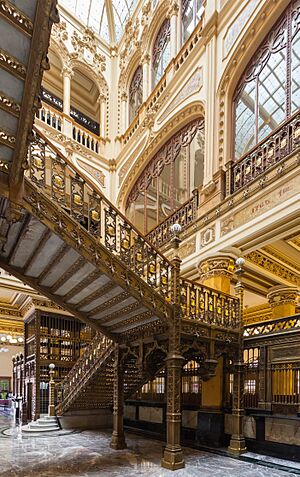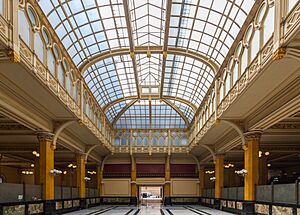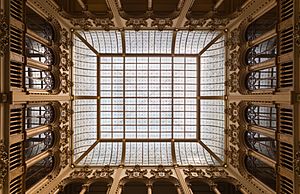Palacio de Correos de México facts for kids
Quick facts for kids Palacio de Correos |
|
|---|---|

View of the Palacio de Correos in Mexico City from the NW
|
|
| General information | |
| Architectural style | Plateresque Revival |
| Location | center of Mexico City, on the Eje Central (Lazaro Cardenas) near the Palacio de Bellas Artes |
| Coordinates | 19°26′08″N 99°08′25″W / 19.435686°N 99.1404°W |
| Construction started | 1902 |
| Completed | 1907 |
| Design and construction | |
| Architect | Adamo Boari |
The Palacio de Correos de México, also known as the "Main Post Office," is a super cool building in the heart of Mexico City. You can find it near the famous Palacio de Bellas Artes. It was built in 1907 and was very modern for its time.
This palace has a unique mix of building styles. It combines many different looks into one amazing design. In the 1950s, some changes were made that actually hurt the building. Then, a big earthquake in 1985 caused even more damage. Luckily, in the 1990s, a lot of hard work brought the building back to its original beauty.
Contents
History of the Postal Palace
Back in 1901, the main mail service in Mexico became its own government group. Before that, it was part of a bigger transportation department. Because so much mail was being sent each year (about 130 million pieces!), they decided it needed its own special building.
An Italian architect named Adamo Boari was chosen to design the palace. He created a design that blended many different styles perfectly. A military engineer, Gonzalo Garita y Frontera, made sure the building was constructed well. The spot chosen for the palace was where an old hospital used to be.
Workers started building in 1902. They used a new technique for the foundation, which was a thick concrete slab with steel beams. This special foundation helped the building stand strong. The palace was finished five years later, in 1907. The president at the time, Porfirio Diaz, officially opened it. He even dropped two postcards into the mail slot to celebrate! For a while, people called it the "Fifth House of Mail" because it was the fifth building to hold the city's postal services.
The Palacio de Correos has been a working post office ever since 1907. However, in the 1950s, the Bank of Mexico next door needed more space. So, they took over a big part of the Post Office palace. They even built two bridges to connect the buildings. These changes removed many of the original decorations. They also made the building much heavier, which put a lot of stress on its steel frame. This extra weight, along with the 1985 earthquake, caused a lot of damage.
Amazing Architectural Style
This palace is famous for its incredible mix of architectural styles! You can see parts of Art Nouveau, Spanish Renaissance, Plateresque, Rococo, Gothic, Venetian Gothic, Moorish, Neoclassical, Baroque, and Art Deco. It's like a world tour of architecture all in one building! The palace also uses a mix of materials from Europe and Mexico. You'll find beautiful marble, plaster, and white "cantera" stone from Puebla.
The building has a strong steel frame and a special foundation. This design has helped it survive many earthquakes. It also prevents the building from sinking, which is a problem for many structures in Mexico City.
The post office is made from a light-colored stone called "chiluca." The outside is covered with cool details, like iron dragon lights and fancy carvings around the windows and roof. Much of the shiny metal work on the outside was made in Italy. Each floor even has windows in a different style! But the repeating arches help keep the whole building looking unified. The main entrance has a large iron canopy, which was a popular style in the early 1900s. On the fourth floor, there's a gallery with thin, twisted columns and a delicate cresting that goes all around the building.
Inside, the marble floors and shelves look great with the bronze and iron window frames, which were made in Italy. The main staircase is amazing! It has two separate ramps that meet in the middle, then seem to cross again higher up before going their own ways. In the meeting room, there are beautiful paintings by Bartolomé Gallotti. These paintings are on a base of real 24-carat gold and show the history of sending messages.
Bringing the Palace Back to Life
From the 1950s to the 1980s, the Bank of Mexico used a big part of the palace. The Bank made many changes, like adding security walls and roofing over open areas. These changes added a lot of weight and stress to the building's steel frame. This caused damage, and the 1985 earthquake made it much worse. Many buildings nearby were also damaged or destroyed.
After the earthquake, the Bank decided to move out of the palace. They built new offices nearby instead. Because of its beauty and history, the Palacio de Correos was declared an "Artistic Monument" in 1987. Restoration work began in the 1990s. This work was helped a lot by old pictures and documents from the National Archives. They even found the architect's daughter in Italy! She shared her father's original plans and notes, which are now at the National Museum of Architecture.
The restoration started by fixing the building's structure. Workers repaired and strengthened the columns and steel beams that the earthquake had damaged. Next, they removed all the extra weight the Bank of Mexico had added. They made the floors the original weight and design again. Finally, they rebuilt the interiors that had been changed so much. The architect's old plans were super helpful for bringing back all the original decorations. This restoration also allowed for new technology to be added to the postal services.
Until 2013, the fourth floor of the palace was home to the Naval Historical Museum. This museum had a large collection of models, photos, maps, and other items about Mexico's history of sailing and the navy.
The museum was divided into six areas, each covering a different time or part of Mexico's sea history. One section showed the beginnings of sailing in both the Old and New Worlds. Another section focused on sea events during the time of New Spain. There was also a part about Mexico's navy after it gained independence in 1821, up to the early 1900s.
One section covered the Mexican Revolution (1910-1920), including a battle between two ships and the U.S. occupation of Veracruz. The "Modern Mexico" section showed events from 1920 to 1970, like Mexico's role in World War II. The last section, "Contemporary Mexico," covered 1970 to 2004. It highlighted the Mexican Navy's newest ships and future plans.
The museum also displayed many paintings. These included portraits of important naval figures and scenes from historical events. For example, there were paintings of the defense of a fort, the bombing of a port, and a lake battle during the Spanish Conquest.
See also
 In Spanish: Palacio Postal para niños
In Spanish: Palacio Postal para niños








